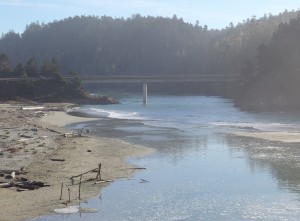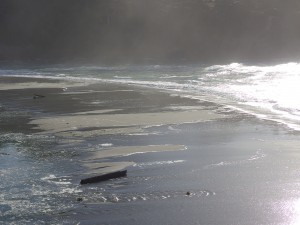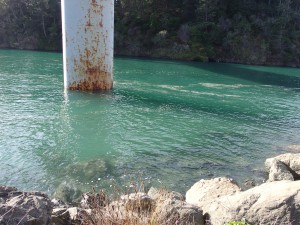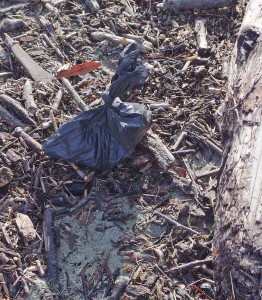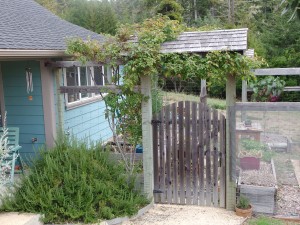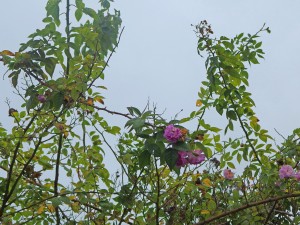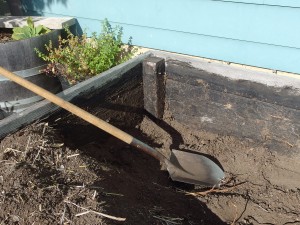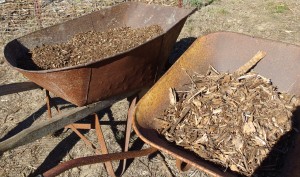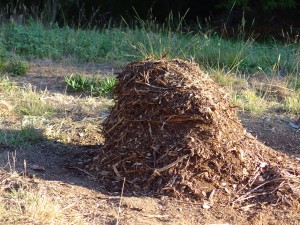Posts Tagged ‘Mendocino Coast’
Citizen/Science
A king tide this morning, and we’d heard that it would be useful for people to document how high the water came, so that we’d have some idea what to expect as climate change brings rises in sea level. An excellent excuse to amble down to Big River Beach in Mendocino with my new camera and practice getting my horizons horizontal.
We’ve had no major rainstorms yet this winter to wash out the sandbar that builds up at the mouth of the river. From a vantage point on the cliff, we watched the tide creep over the bar, then took the old steps down to the beach to check on the tide height at the bridge. Yes, the water was high, too high to walk on sand and touch the bridge pier, as we can usually do.
Strolling back along the tide line, we were enjoying the peace and quiet beauty of the scene when I noticed something that set my teeth on edge: a plastic dog poop bag discarded by a driftwood log. I’ve seen such offerings frequently around this region: beside a signpost, on the edge of a trail. I want to shake the humans who leave them, who are so unclear on the concept of citizenship they have no thought for the environmental mess they are causing. It’s no wonder the sea level is rising.
Texts
Searoad, a story collection by Ursula K. LeGuin, has a permanent place on my bedside table. It’s there because every now and then I need to reread a certain story. A very short story, less than three pages, it is titled “Texts,” and tells of an older woman who, bombarded by messages and calls to action, retreats to the coastal Oregon village of Klatsand for a month-long winter break. As she walks on the deserted beach, she notices that the waves have left messages in the lines of foam, messages she can almost decipher. The laciness of the foam leads her to speculate that crochet work and lace might also be legible. In a handmade lace collar she reads a message that seems directed to her: “my soul must go, my soul must go … sister, sister, light the light.” There the story ends, with the woman not knowing “what she was to do, or how she was to do it.”
I think of this oddly moving little story every time I walk on Ten Mile Beach, as I did last Sunday. The receding waves left undulating lines of bubbles, iridescent in the hazy sunlight, that popped to form patterns of foam. Scattered across the beach were strands of bull kelp, dried into coils and loops that lay like a cursive script on the sand.
Yesterday, when the wind was brisk and the sea streaked with white caps, I remembered an interview I did for the Mendocino Art Center magazine. It was part of a series I wrote on artists who helped found the art center in the 1960s. By the time I met Jim Bertram in the early 2000s, he was senile and nonverbal, so I had to rely on material in the art center archives for information about his background and artistic vision. Nevertheless, Jim and I spent a wonderful afternoon together. I think a poem I wrote at the time sums it up:
MESSAGES
For JB
“Line expresses the inner thought. It is a narrative of what we really want to tell each other but somehow can’t seem to verbalize.”
– Jim Bertram
These bright spring days, when the wind
scribbles its white calligraphy
on a wash of aquamarine,
I think of the artist in his studio
upstairs of a weathered storefront
overlooking Mendocino Bay.
Sheet after curling sheet he showed me, canvas
after canvas, covered with calligraphic forms
that could have been words, but were not.
In our shared silence I understood his drift:
how sometimes what matters most is inarticulate:
like the line of spray from a lifting wave,
the hand of an old man painting messages of love.
On my way downstairs from Jim’s studio, I fell in love with one of his paintings, which now has a place of honor in my house. I smile when I read its message.
Battle of the Rose Roots
I should have learned from experience. Years ago, I wondered why plants near a hedge in my Palo Alto garden weren’t doing so well, in spite of soil amendments, regular watering, and other tender loving care. Investigating closer, I found that below the soil surface was a dense mass of tiny white roots. The nourishment stealer was a Banksia rose that had flourished in the hedge for fifty years.
You would think I’d learn and remember. But no … As we designed a deer-fenced vegetable garden for our new home on the edge of the forest in Mendocino, we decided that a covered gate, an English lych-gate, would be a charming touch. And wouldn’t it be romantic to have a rose climbing over it? I’ve always been fond of “Mrs. Cecille Brunner” with its exquisite miniature pink buds.
I planted a climbing “Mrs. B” in a half wine barrel just inside the gate, out of the deer’s reach. Years passed. At a friend’s house I admired another pink climber. She told me its name, “Seven Sisters,” and offered a cutting. The local legend, she told me, was that this rose was originally brought to the Northern California coast by a Russian princess in the early 1800s. Possibly she was the well-born wife of Ivan Kuskoff, commander of the Russian American Company fur trading post at Fort Ross, whose house is still standing, and is now a National Historic Landmark. According to the story, Madame Kuskoff gave cuttings of “Seven Sisters” to friends, who gave cuttings to friends, and so it moved up the coast. I see it everywhere in the gardens of old coast homes, and have met the woman who gave my friend her cutting.
But I digress. Needless to say, my cutting of “Seven Sisters” also found a home in a wine barrel inside my fenced garden. It became a yearly task to prune these enthusiastic climbers before they totally blocked the sun from the vegetables.
This year “Seven Sisters” decided to bloom again just as I was getting out my pruning shears, so she’s still a wild tangle.
But tidy on top doesn’t mean disciplined underneath. This season I noticed that the vegetables in raised beds near the roses were stunted and sad. One scoop with the shovel showed the cause. Nothing for it but to dig out the entire bed.
There’s a layer of hardware cloth on the bottom to keep out the gophers (that’s another story). I’m hoping a couple of layers of weed cloth will deter the rose roots, at least for a few years. My friend, a Master Gardener, laughed when I told her. “You’re the eternal optimist, aren’t you?” she said.
Compost
I love the miracle of compost. There is a circularity to it, the way plants in their dying return nourishment to the soil that sustained their lives. I have compost bins, of course, wire frames in which I layer garden refuse, kitchen scraps and dry material. I compost vegetable matter only, because of our resident wildlife, and keep a wire mesh lid on the currently active bin. It’s not entirely satisfactory. I cannot raise a hot enough temperature to kill all the weeks seeds. I’m envious of our local Mendocino Coast Botanical Gardens, which receives regular donations of spent grain and hops from nearby North Coast Brewing Companyto boost their compost processing temperature.
Right now I’m digging out my favorite kind of compost, a huge pile of chippings from a neighbor’s tree trimming and bush pruning that has sat in the meadow behind the house for about three years. The chippings were not great. Even now, the pile contains a lot of sticks, which I have spread under my orchard trees. They’ll decompose in time, and meanwhile provide some deterrent to the meadow grasses.
Sieved out from the sticks is the treasure: rich black compost, free of weeds, to spread as mulch around the garden. The plants are smiling.
Sweet Peas
The 2012 Mendocino Coast Writers Conference ended last night. This morning I picked sweet peas. Over my four-day absence to run the conference, the stems that had been in bud were in full flourish, and the row of pea plants sprawled even more rampantly over chard and carrots in my vegetable garden. I picked enough to refill vases of crumpled has-beens in my house, enough to give away to a friend, enough to fill yet more vases. I pressed my nose into the bouquet, sweet as the hugs of farewell and murmured words of thanks at the conference’s closing dinner.
The scent restored my faith in myself, both as the director of a successful conference, and as a grower of sweet peas. Back when I was a child in school, growing sweet peas was part of the curriculum, like spelling and arithmetic. Each year the Important Visitor would bring the signup sheet and reveal the wondrous names of new varieties. On Seed Day the visitor would return. Precious pennies would be offered up for hard black miracles. The visitor would give instruction in the mysteries of sweet pea growing. We must dig a trench two feet deep. The layer of compost in the bottom of the trench must be at least six inches before we shoveled back the dug and loosened earth. We must soak the seeds in water overnight, then plant exactly one inch deep, and four apart.
The best on Judgment Day took front row place at the flower show, a ribbon tucked beneath a jam jar that held three specimens, each with four blooms on a long stem. My jar sat humbly at the back. I was racked with guilt for shorted measure on the trench. The ground was hard, and my arms ached. My Dad’s compost pile yielded only a thin layer of partially composted weeds. I had tossed in some fresh grass clippings, but even those did not make up the required six inches. The seeds germinated, but the plants were spindly, and none of their flower stems boasted more than three blooms.
The guilt stayed with me all my life. Not enough my love for their bright beauty, not enough my penitence. I was cast down.
This year I decided to try again. A raised vegetable bed had an empty row next to a sheltered wall covered with a strong wire trellis. Remembering my past efforts, I figured that would be enough space. I dug in a bag of soil conditioner with an impressive ingredients list: composted firbark, chicken manure, earthworm castings, bat guano and kelp meal. I planted my seeds, an old-fashioned mix from Renee’s Garden, careful to places them one inch deep and four apart.
The seeds grew. And grew. I wound string from post to post to hold the plants against the trelllis. More string. A length of chicken wire that bulged and sagged. A couple of tomato frames. Soon I gave up. The chard was running to seed anyway, and the carrots were mature enough to survive the shade.
This morning as I teetered on a step-stool to pick the flowers, the thought came to me that their exuberant growth was akin to the joy conference participants were expressing. The Mendocino Coast Writers Conference has as its mission to offer a place where writers find encouragement, expertise and inspiration. This year it all came together. A brilliant group of faculty shared their expertise with participants dedicated to improving their craft, nurtured by a team of volunteers so cohesive that the flow of events was seamless.
Today we’re all exhausted and resting up. Tomorrow we start planning MCWC 2013.
Edge of the Creek
High tide was at dawn. By noon, the breaking waves are far distant, and the creek on its way to the sea has cut a miniature cliff through damp sand. A reflection of sun on water ripples along the vertical face, fluted already by tiny sand-falls. As I watch, more sand avalanches skitter down to where, about half-way to the water, an undulating line with a little thickness to it, like a welted trim, defines where the vertical cliff gives way to a more gradual slope. The damp sand grains bounce off the ridged line and spread out down-slope, coming to rest at about forty degrees, their angle of repose. The scene is a microcosm of the world’s geological processes, the lifting up of land masses, the crumbling away. But what strikes me most is the beauty of it: the rippling light, the fluted cliff, the flurries of sand. I am mesmerized by pattern.
Striking a Balance
A gloriously clear day after the first big rain of the season, and the garden calls. Where to start? I need to strike a balance between our enjoyment of beauty and the garden’s needs. The lavender still gives off its evocative scent, and its color is still purple, a gray-purple, like twilight clouds. But if I leave it much longer the stems will die off. Besides, more rain is due in a couple of days, so soon the soil will be too wet to walk on. The task has to be done today.
Even now, where to cut is a challenge. Snip too high, and each rounded bush will resemble a pincushion. Too low, below where a small gray-green pair of leaves has sprouted, and the stem will die anyway. I don’t have time to manicure each individual stem. I take a breath, grab a handful of stems, and cut.
A flotilla of coyote bush seeds sails by on the wind. Negotiating the balance between garden plantings and native vegetation on this stretch of the Mendocino Coast requires the patience and skill of a diplomat. Coyote bush was here first, and provides excellent forage for the small, seed-eating birds that flock here in the fall. Douglas fir grows here too, and Douglas iris, and blue-eyed grass. Again, a balance. The Douglas fir seedlings have to go if they are close to the house. Iris and blue-eyed grass get to stay. Coyote bush, the most prolific, I allow on the outskirts of the garden. But here where it would crowd out the lavender, no. I reach down and yank out babies from between the lavender bushes.
Against Entropy
Such a long gap of time between posts. But now this year’s Mendocino Coast Writers Conference is over and, as I always do after a major project is completed, I am attempting to clean up my midden of a desk. I’m reminded of a novel I read back in the 1960s. The author was Michael Frayn, and the somewhat forgettable plot was about a bunch of hack journalists in London who were bored with their jobs. It’s the title that stuck in my mind: Against Entropy. The notion that our lives are a constant struggle against disorder and decay.
The surface of my desk is now visible in parts. I still have files to sort, both computer and paper. But I no longer despair of restoring order.
The conference was a success. Not financially, in this economically troubled year, but in the quality of instruction and the spirit of community the participants felt. Their glowing evaluation comments made our efforts worthwhile.
Now on to planning the 2011 conference…
Catching my breath
Countdown to the Mendocino Coast Writers Conference, which starts next Thursday, July 29. Amazingly, I’m caught up for the moment on co-director tasks. Time to take a deep, relaxing breath and think about the wealth of wildlife with which this place is blessed. Last evening, on the hill behind our house, we saw our first California gray fox of the season. A cottontail scampered out of sight as a pair of angry scrub jays attacked the fox. Later, the stags emerged, two of them, both with magnificent six-point racks of antlers. We’ve been watching the new season’s fawns gradually lose their spots. A jack rabbit family shares the front garden with the quail family. Hummingbirds and bees have discovered an exotic treasure from my native New Zealand: a young Metrosideros excelsus. It is commonly known as New Zealand Christmas Tree because on the northern coast of New Zealand its spectacular clusters of red flowers bloom in December. Here on the other side of the world, where summer is on the other side of the calendar, it has been brightening our gray July. We call it by its Maori name, Pohutukawa.
A Long Tradition
Thirty-five years ago, a bunch of hippies in Mendocino started a tradition of getting together to read their poems. Many of the original group were at the Hill House last Sunday, to reminisce about the old days and to read their work at the 35h Anniversary Mendocino Spring Poetry Celebration. Produced by Gordon Black and hosted by Sharon Doubiago and Dan Roberts, the event drew 46 poets, of whom I was privileged to be one. I felt I was part of history.
